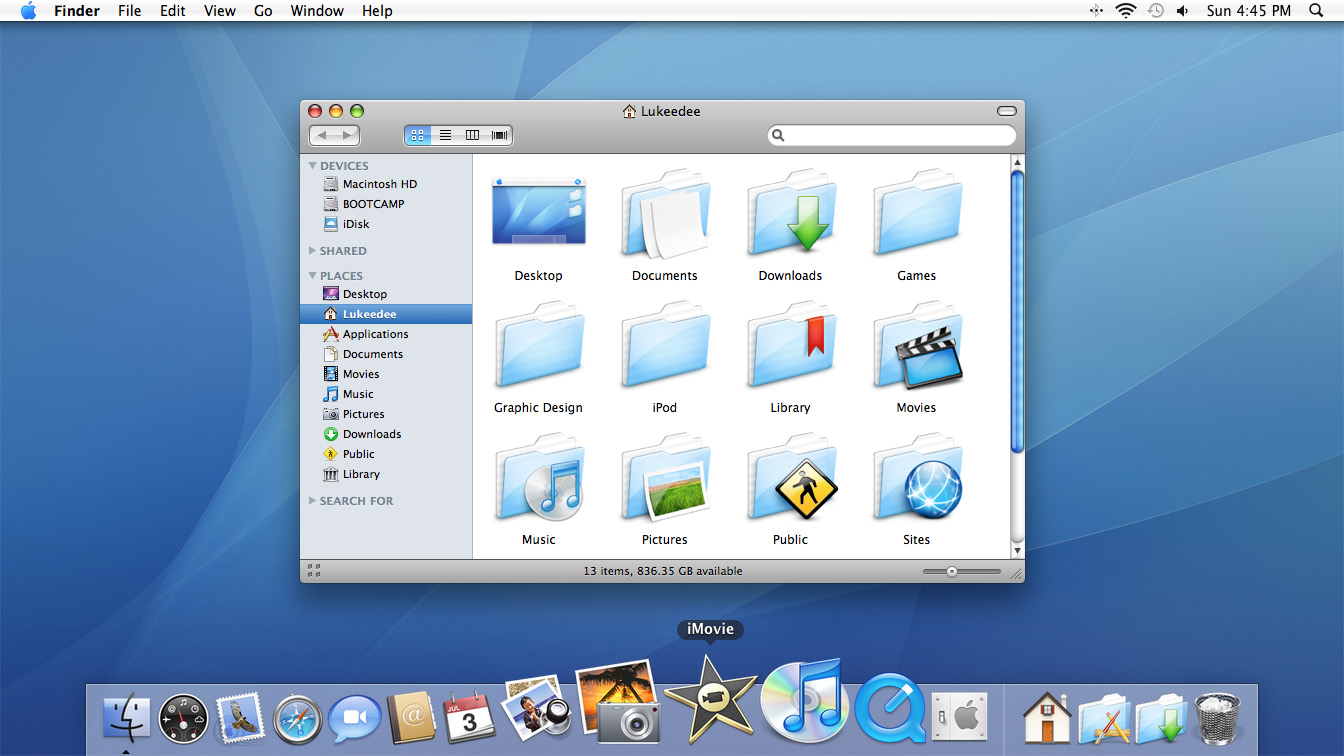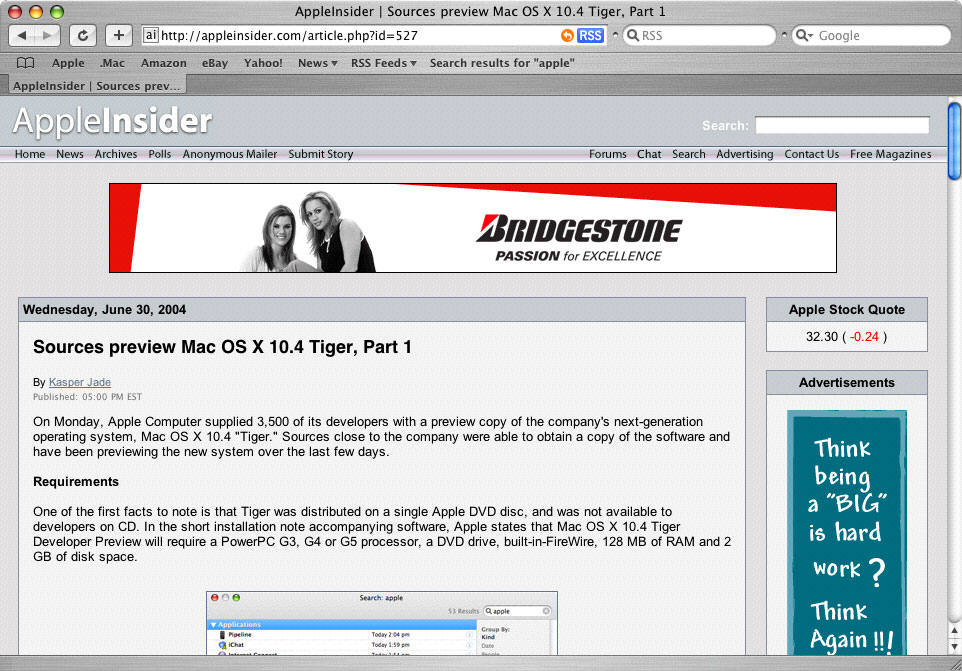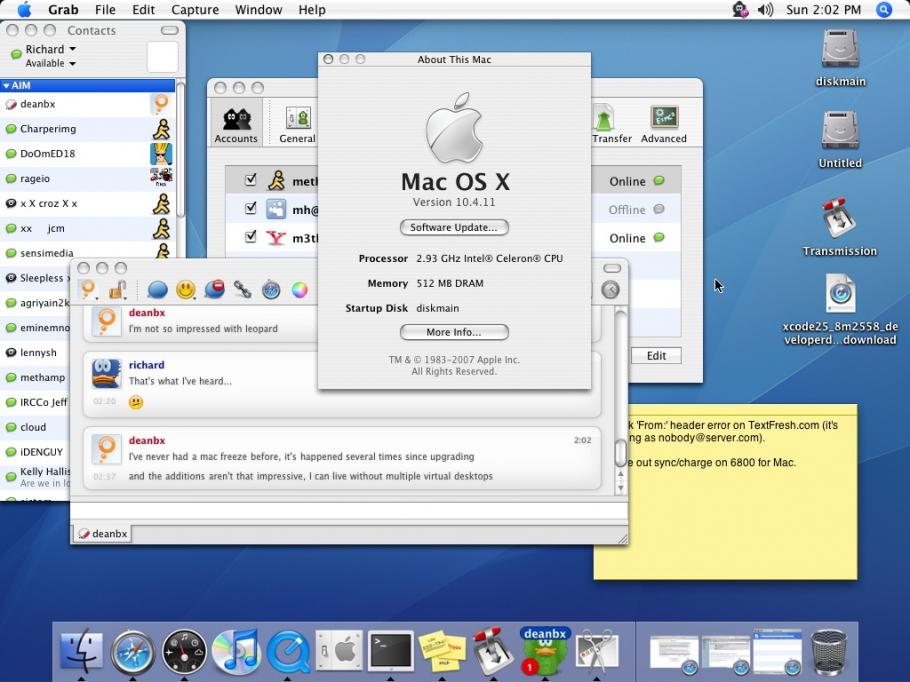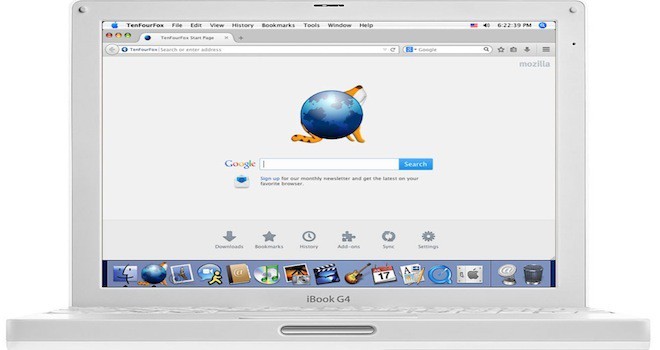Mac OS X 10.4.10 was released on June 20, 2007. It has the build number 8R218 for PowerPC and the build numbers 8R2218 and 8R2232. The following improvements apply to both Intel- and PowerPC-based Macs unless otherwise noted. With the introduction of Mac OS X v.10.4 (Tiger), Apple has brought the Macintosh platform to new levels of ease of use, performance, and reliability. It is a great platform for our latest generation of Macintosh-compatible software. This past year has been an exciting one for customers that rely on Adobe and Apple products. Apple: How to boot from ISO without USB stick or DVD on Mac OS X 10.4.11 Tiger?Helpful? Please support me on Patreon: https://www.patreon.com/roelvandepaarW.
- The all-new Adobe Creative Suite 2 and Mac OS X v.10.4 (Tiger) make this a great time to be an Adobe customer on the Mac platform. Adobe and Apple have worked closely together through the development of Mac OS X 10.4 (Tiger) and Adobe Creative Suite 2 to.
- Mac OS X Tiger 10.4 Intel/PPC by Apple, Inc. Publication date 2006 Topics Mac OS X Tiger, Intel x86-64, PowerPC, Mac OS X 10.4.x, Mac OS Tiger 10.4.5, Mac OS X Tiger.
Os X 10.4 Torrent
When you start using an upgraded version of a familiar piece of software, the first things you notice are the changes. In those initial sessions, it’s hard to tell whether those changes are for the good or not—all you know is that they’re different . But then, slowly, you begin to form judgments about the new features, to appreciate small touches that originally escaped your notice. This is where I am with Tiger.
Spotlight’s Shades of Gray
Spotlight is undeniably cool. It’s Tiger’s most important feature, and it’s miles beyond any of the old search features in the Mac operating system (yes, Sherlock, I’m talking to you).
That’s because Spotlight doesn’t just search text inside of your files. It also knows about your files’ attributes —who authored a Microsoft Word file, for instance, or which camera snapped a JPEG. Different apps can define their own descriptors, but Apple is distributing a list of “common attributes” that it’d like programs to share.
I also really like the Smart Folders feature, which Spotlight enables in the Finder. Smart folders have solved one of my own workflow problems: Spotlight can sort through my folder of e-mail attachments to find all the Macworld stories I need to read, and it puts them all in one convenient place.
However, Spotlight also has a major limitation: at this point, it works only on a file-by-file basis. It won’t find e-mail messages, for example, in programs (such as Entourage) that save messages as individual files. Apple and software vendors need to find a fix for that, so we can truly uncover all the data on our Macs.
Still, I like Spotlight. In a year, I think it will be seen as the most important feature ever added to OS X. If you deal with an avalanche of files, be they Word documents, images, or whatever, Spotlight alone will make upgrading to Tiger worthwhile.
Dashboard in Progress
As a paying user of Konfabulator, I like the idea of small, single-purpose application widgets. And some of Apple’s new Dashboard widgets are very useful. The Dictionary widget is perfect, letting me look up a word quickly without launching the new Dictionary application.
However, some of Apple’s widgets are not as useful as they could be. The Calendar widget doesn’t integrate with Apple’s iCal. And the way you add new widgets to your Dashboard—clicking on a rotating X symbol at the bottom of the screen to reveal a strip menu of available widgets—is clumsy. As the number of widgets grows, it’ll just get clumsier.
Moving widgets off of the Dashboard layer is also awkward. If a widget would work better for me on my desktop, why can’t I move it there without resorting to Terminal? (It would have been nice if Apple had let us deploy widgets more flexibly.)
More Feature Favorites
Among my other favorite new features:
Amazon.com: Mac OS X Server 10.4 Tiger - Unlimited Clients ..
Multiuser videoconferencing works surprisingly well in iChat AV 3.0, and group support in the Buddy List window is excellent. But I wish it were easier to start a multiuser videoconference. Right now, you and your friends have to figure out whose Mac is fast enough to host the conference. iChat should do that for you.
Safari 2.0 ’s support for RSS feeds should help bring RSS technology into the mainstream. But putting RSS feeds in a Web-page interface makes me think that Apple missed the point of Web-site syndication. And the new Private Browsing feature fails to wall off Safari’s previously stored cookies, so Amazon.com will not only greet you by name, as usual, but also track any pages you visit in a supposedly private session.
Finally, a few words in praise of Automator. It’s exciting to see the power of Apple’s scripting technologies being placed in the hands of millions of Mac users who will never, ever write even a single computer program. Now the impressive automation features of AppleScript are available to the rest of us. That’s great news.
Should You Upgrade?
Let’s be realistic here: if you’re an active Mac user who plans to continue buying new software and hardware on a regular basis, Tiger is a necessity. If you’re not planning on buying any major upgrades and your Mac works fine just the way it is, you can probably get away with skipping it. If you’re somewhere in between those two groups, Tiger is probably in your future. Once it’s been prowling the Mac world for a few months—time enough to shake off the bugs—you’ll start to get the itch to upgrade. And you’ll be glad you did.
Getting an old (2002) 700 MHz iMac G4 with just 512 MB of memory up and running reminded me of what a nice – and still useful – operating system Mac OS X 10.4 Tiger is, especially on that old Apple PowerPC hardware.
I wouldn’t normally run Tiger with just 512 MB of memory, but that’s what came with the computer, and I’m not going to throw money at it. Likewise, it has a very pokey hard drive with just 40 GB capacity, but it’s not like this is going to be a production computer. (If it were, I’d transplant one of my higher capacity 7200 RPM hard drives.)
I used Tiger daily until about three years ago, when Low End Mac moved from using Claris Home Page 3.0 in Classic Mode, which requires Tiger or earlier versions of OS X, to WordPress, which is a browser-based content management system (CMS). I used Home Page when I began Low End Mac in April 1997, and it was early 2013 that I finally found and moved to a better solution.
Classic Mode is at its best on a dual-processor Power Mac, because it can dedicate one CPU full time to Classic Mode while the other handles all the OS X details. But once I retired Home Page, I no longer needed to use Tiger on a regular basis – I moved to OS X 10.5 Leopard on my Power Macs and 10.6 Snow Leopard on my 2007 Mac mini.


There was only one reason I ever switched from Tiger to Leopard – NetNewsWire had switched to using Google’s RSS feed manager (since discontinued), and that version of the app required Leopard. If not for that, I would have stuck with Tiger. It was perfectly adequate for my needs, and it’s still good enough for a lot of people to continue using it, especially on PowerPC Macs. (I’ve never used Tiger on an Intel Mac, but unless it has less than 1 GB of system memory, you’re better off with Snow Leopard on Intel Macs.)

Browsers
Any Mac running OS X Tiger can run TenFourFox 38, a port of Firefox optimized in separate versions for G3 and G5 CPUs, along with two G4 versions depending on which chip variant you have. Sure, Firefox for supported platforms is at version 47 now, but TenFourFox 45.3 is in its second. (Rather than port every version to PowerPC, TenFourFox only works on the ESR, Extended Support Release, a sequence that includes 38 and 45 but nothing in between.)
As we’ve said time and again, if you have a PowerPC Mac running Tiger, TenFourFox is the best browser going. You even get full screen mode, something most Mac apps didn’t get until OS X 10.7 Lion or later. And Simon Royal has shared some tips on tweaking TenFourFox to be even more responsive.
Google’s Chrome browser was never ported to PowerPC, Firefox officially dropped Tiger support before Firefox 4 was released, and Safari is hopelessly old and outdated at version 4.1.3 from 2010. I’d go with Camino as my alternate Tiger browser. It’s a Mac-specific port of an earlier version of Mozilla, very lightweight, and pretty responsive, but without the flexibility and power of TenFourFox.
Probably the biggest problem with older browsers is that some websites, especially banking and the like, may not support your old Mac. Then again, there are parts of the company website for my current employer that I can’t access on my MacBook running OS X 10.11 El Capitan. Some sites don’t like Macs. Some sites don’t like any browser not made by Microsoft.
Office Apps and Suites
As long as you’re using OS X 10.6 Snow Leopard or earlier, you can’t go wrong with AppleWorks 6. AppleWorks used to come free with every iMac, and it’s the best integrated office suite ever. Working with Microsoft Office and Apple’s iWork apps has convinced me of that. Peggle™ nights download for mac. With AppleWorks, a single app handles word processing, spreadsheets, presentations, vector art, and more. (The database is probably its weakest component.)
Microsoft Office is powerful, but its also bloated and composed of several separate apps, unlike AppleWorks which is fully integrated. LibreOffice 4.0.2 (the last PowerPC version) is powerful but slow. Ghost files 2: memory of a crime crack.
For word processing, TextEdit is free and decent, but the freeware Bean word processor is even nicer. Version 2.4.5 is the last to support OS X Tiger.
Unleash the Tiger


The best thing you can do for Tiger is run it on a dual-processor Power Mac G4 or G5 – or the truly awesomely powerful 2.5 GHz Power Mac G5 Quad – with plenty of memory. Tiger can run with less than 512 MB, but that’s a realistic minimum for decent performance. 1 GB is nice, 2 GB is great, and more than that, even better, although you need a G5-based Mac if you want to access more than 2 GB of memory.
Regardless of how many processors your Mac has or what speed it runs at, more memory will always help OS X run better. That’s as true for the original version as it is for macOS Sierra.
The next best thing you can do, after installing all the memory you can, is to use a fast hard drive or SSD. I’ve been installing 7200 RPM drives in my Macs for about 15 years now, and it really makes a difference. An SSD would be even faster, but make sure you get one that works well with PowerPC Macs – and the Classic Mac OS, if you ever plan on booting directly into Mac OS 9. Note that Tiger does not support drives over 2 TB.
Or Just Playing with Tiger
If you’re just going to use the old Mac for AppleWorks, browsing the Web lightly, and some vintage Mac games (I love Sim City 2000), an old G3 or G4 Mac with Tiger works well. It’s less demanding of hardware resources than Leopard, and it would make for a very nice homework machine. After all, you probably can’t out-type a 16 MHz Mac II, let alone a 300 MHz G3.
I would look to slot-loading iMacs, G4 iMacs, a Lombard or Pismo PowerBook, any G4 PowerBook, or any Power Mac from the Blue and White model forward as good Tiger candidates.
Conclusion
Sure, there are theoretical insecurities in Tiger and Leopard and Snow Leopard that are never going to be fixed, and there is only one close-to-up-to-date browser for Tiger, but even the latest operating systems – including macOS Sierra, Windows 10, Chrome OS, and every flavor of Linux – has some undiscovered security issues. It’s the nature of a modern operating system. I wouldn’t worry too much about it.
When I set up an old G4 or G5 Mac, I partition the hard drive with one-quarter to one-third of the space for OS X 10.4 Tiger, the other partition with OS X 10.5 Leopard, which has some slightly more modern browsers, some alternative browsers (Stainless and Roccat, for instance) not available on Tiger, and can be used to run a Time Machine backup drive for your network (2 GB maximum drive size!).
But overall, I could be happily working with Tiger today. It will squeeze the most out of that old PowerPC G3, G4, and G5 hardware, and it will let you blast into the past with Classic Mode (see Low End Mac’s Compleat Guide to Mac OS 9). In fact, Classic Mode gives you a browser option not available to those running OS X Leopard and later: Classilla runs very nicely under Mac OS 9.x and is set up to access websites as though it were a mobile browser, which should really speed things up.
If you’ve got old Macs, give Tiger a try.
Keywords: #osxtiger #macosxtiger #tenfourfox #classicmode
Short link: http://goo.gl/doxXgI
searchword: tigerstilluseful
Related
